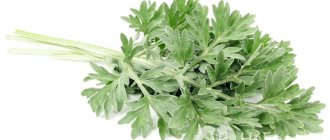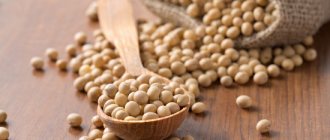Soy sauce gained wide popularity with the advent of oriental cuisine into mass culture. In Asian countries it was successfully used even before our era. The main use was in preparing Japanese dishes, primarily sushi. Now, it is added to many dishes as a flavor enhancer.
The seasoning gained its popularity thanks to its unusual salty and at the same time spicy taste. But its effect on the human body also deserves attention. It can be both beneficial and harmful, depending on the amount of use and health status. Rice vinegar is popular in Eastern countries; read about its beneficial properties. We use coriander and spicy cloves more often in the kitchen, but they have a lot of healing properties.
The product is prepared on the basis of specially processed soybeans. To improve the taste, salt, spices, and auxiliary components are added.
One of the main components is vegetable protein, which gives it a special consistency, taste and characteristic color. Starchy corn syrup adds a viscous consistency, and a special set of spices adds a unique piquancy.
Composition and calorie content of soy sauce
Composition 100 gr. soy sauce as a percentage of the recommended daily intake is presented below.
Vitamins:
- B3 – 20%;
- B6 – 10%;
- B2 – 9%;
- B9 – 5%;
- B1 – 4%.
Minerals:
- sodium – 233%;
- manganese – 25%;
- iron – 13%;
- phosphorus – 13%;
- magnesium – 10%.1
Calorie content of soy sauce – 60 kcal per 100 g.
Expert opinion on storage
Leading brand manager of the Japanese international company Kikkoman in Russia Olga Tikhonova shared the basic rules for storing soy sauce:
- optimal temperature – from 0˚C to 25˚C;
- insulation from heating devices and exposure to UV rays on the container;
- The shelf life of a sealed bottle is 12 months.
It is better to store opened sauce in the refrigerator.
After opening the consumer container, it is recommended to store soy sauce in the refrigerator for 10 to 30 days.
Benefits of soy sauce
Soy sauce contains biologically active components that have strong antioxidant properties and resist the development of many diseases.
For the bones
Genistein has a high anti-osteoporotic effect and prevents the leaching of calcium from bones in women during menopause.2
For the heart and blood vessels
Use 60 mg. soy protein isoflavones reduce the risk of developing cardiovascular diseases in postmenopausal women.3
Soy sauce cleanses the walls of blood vessels from cholesterol and normalizes blood pressure.
For receptors
The sauce enhances all five flavors due to the presence of a natural neurotransmitter - monosodium glutamate.4
For the liver
The protective effect of genistein in soy sauce has been noted on damaged liver and fibrosis caused by chronic alcoholism.5
For diabetics
The product has proven itself in the treatment of patients with type II diabetes. Genistein lowers blood glucose levels and inhibits its uptake.6
For women
Genistein and daidzein in soy sauce mimic the female hormone estrogen, so they can inhibit the natural production of this hormone in women during their reproductive years. They are beneficial for postmenopausal women and reduce the risk of breast cancer.7
For skin
Research has shown that genistein may be helpful in reducing the symptoms of dermatitis when taken daily.8
For immunity
The high content of antioxidants inhibits the aging of the body. The product strengthens the immune system, activates the body's defenses and reduces the occurrence of allergic reactions.9
Medical research
A 19-year-old boy with unusual poisoning was taken to a clinic in one of the US states. As it turned out, he drank an entire bottle of soy sauce on a dare. Due to the large amount of salt, the guy fell into a coma for three days - this is an example of the harm of salt in soy sauce.
You need to be careful when using sauce as a salt substitute. A tablespoon of soy sauce contains a shameless amount of salt - 1024 mg. Salt lowers testosterone in men, which leads to a decrease in muscle volume, increased growth of fat layers, impaired sexual functionality, irritability, etc.
Soy sauce for men
Due to compounds similar in composition and properties to estrogens, soy sauce is healthier for women than for men.
Regular consumption of soy sauce reduces the concentration of male sex hormones, since the components of soy sauce have antiandrogenic activity in the testicles, prostate gland and brain.
Excessive consumption of soy and soy sauce increases hair growth in middle-aged men, indicating decreased testosterone levels.11
On the other hand, the antioxidant content strengthens the body, and isoflavones inhibit the development of testicular and prostate cancer.
What kind of plant is soybean?
The homeland of soybeans is China, where it is called “shu,” which means “big bean.” An annual plant from the legume family, it was domesticated in Asia before our era. The culture was brought to Europe at the beginning of the 18th century and immediately found consumers. Now it is grown on all continents except Antarctica. Soybeans are grown in America, Central and South Africa, Australia, and India.
Soy is a controversial food that causes a lot of controversy in scientific circles . Among the people, the plant is popular among vegetarians, who use it as a substitute for meat.
Cooking uses the unique properties of soy to prepare a variety of food products. In the East, cheese made from soy protein - tofu - is popular. They also make soy milk, which tastes like cow's milk. Russians are more familiar with soy sauce.
Harm and contraindications of soy sauce
The harm of soy sauce was noted when consuming a product made with a violation of the fermentation process. Do not buy soy sauce in markets or from unverified manufacturers.
But even a high-quality product has contraindications:
- intestinal diseases . Salt, which is used in the production of soy sauce, can be deposited in the body and irritate the surface of eroded intestinal walls;
- age up to 5 years , since it is unknown how the child’s body will react to it;
- allergies – cases are rare, but you should monitor the body’s reaction the first time you use soy sauce;
- early pregnancy – high levels of hormones can cause miscarriage.
Some researchers have noted cases of migraine attacks with soy sauce abuse.12
How it is used in cooking
The seasoning can be used both in its pure form and for preparing various Asian dishes. Soy sauce is especially in demand when serving sushi, rolls and maki. Various sauces are also prepared on its basis with the addition of:
It is suitable for meat and fish dishes, vegetables and flour products. It is used in the preparation of soba noodles, udon and funchose.
Soy sauce is a versatile product in the kitchen that can simultaneously replace salt, mayonnaise or butter.
How to cook at home
It is not possible to create an identical copy of soy sauce at home. It will taste different from the original, but will not become a less tasty and healthy seasoning for dishes.
- Soak the beans in water for 8 hours.
- Cook the soybeans over low heat until tender.
- Crush the beans into a paste with butter.
- Add broth, salt and flour to the mixture.
- Bring the mixture to a boil and cook for several minutes.
It is recommended to store the sauce in a glass container with an airtight lid at a temperature not exceeding 10˚C.
Funchoza with seafood
Asian cuisine is rich in nutritious dishes with rich flavors. Funchoza is a bean noodle that has a glass appearance and the ability to be combined with any food.
- Funchoza – 300 g
- Soy sauce – 2 tbsp.
- Seafood (shrimp, squid, mussels, scallops) – 200 g
- Garlic – 2 cloves;
- Green peas – 100 g
- Sweet pepper – 1 pc.
- Parsley – 1 bunch
- Lemon juice – 2 tbsp.
- Salt, pepper - to taste
- Clean seafood.
- Prepare a marinade from lemon juice and soy sauce.
- Marinate seafood for 30 minutes.
- Pour boiling water over the funchose and leave for 7 minutes.
- Drain the noodles in a colander.
- Sauté peas, bell peppers and garlic in a wok.
- Add seafood. Fry for another 7 minutes.
- Add the prepared funchose. To stir thoroughly.
Before serving, noodles with vegetables and seafood should be sprinkled with finely chopped parsley. If desired, you can add sesame seeds.
Funchoza should be eaten warm, as when cold it sticks together and becomes less attractive.
How to choose soy sauce
Traditionally, soy sauce is made by fermenting soybeans, salt and wheat. Be careful because many varieties on the market are produced artificially using chemical hydrolysis. Such products are harmful and may contain carcinogens.
Note:
- The label of properly prepared soy sauce always states that it is a fermented product;
- A good product contains only soy, wheat, salt and water. Avoid dyes, flavors and preservatives;
- too dark a color and sediment on the walls indicates a low-quality product;
- To make the product cheaper, peanuts are added to it, which does not improve its properties.
Soy sauce with the addition of citrus peel is healthier than without it - it contains more antioxidants. A high-quality product has a protein content of at least 6-7%.
What is known about him
Soy sauce is a dark brown liquid with a thick consistency and a characteristic odor. It is obtained by natural fermentation of soybeans using Aspergillus fungi. This product first became known more than 2500 years ago in China. In the 6th century, Buddhist monks brought the recipe to Japan.
It was the Japanese who improved manufacturing technology, they were able to:
- add wheat grains and sea salt to the composition;
- add alcohol as a preservative;
- extend the fermentation period of the product.
The sauce perfectly complements the taste of vegetarian egg rolls.
Thanks to hard work on improving the taste, we were able to create real soy sauce.
Holland is rightfully considered the best producer of soy sauce, although its homeland is China.
What production technologies exist
The recipe for preparing the seasoning has remained virtually unchanged over the past millennia. The emergence of innovative technologies has allowed companies to improve the production process. However, whether these innovations can be called successful or not is up to consumers to decide.
How to prepare in the old days
The process of preparing real soy sauce lasts from 40 days to several years. To do this you need:
- Steam or boil soybeans in water.
- Grind wheat grains into flour.
- Mix with beans and salt.
- Leave to ferment naturally.
- Filter the finished product.
The result is an organic sauce that does not contain artificial preservatives and yet has a powerful disinfectant effect.
What contemporaries did
Swiss entrepreneur Julius Maggi launched the production of chemical soy sauce in 1886. To do this, he used the technology of splitting vegetable protein with hydrochloric acid concentrate. As a result, the beginning of the 20th century became famous for the chemical attack on beans. Modern manufacturers, using the method of obtaining hydrolyzed vegetable protein, can produce products with a ripening period of several weeks.
However, not everything is so smooth, because the resulting sauce does not have the desired color, consistency, aroma and taste. To impart all these qualities, the use of additives is required:
- caramel coloring;
- corn syrup;
- artificial sweetener;
- genetically modified components.
Julius Maggi
As a result of preparing the seasoning in an unnatural way, the carcinogen chloropropanol is formed, which is dangerous to human health. According to the European Union, higher levels of the carcinogen were recorded in chemical sauces from Vietnam, Tajikistan, the Philippines and Taiwan.
In 1 liter of soy sauce, the concentration of chloropropanol should not exceed 0.33 mg.
Application
Having determined that brown seasoning has more benefit than harm, you should take a closer look at the recipes. Oriental cooking is not complete without the additive, and other cuisines around the world use it with pleasure. Asian countries consider the use of soy sauce to be a special tradition that has been honored for generations: moderate use of the seasoning helps to diversify the taste of dishes, adding sophistication to them. Chicken in a spicy marinade, sushi, salads, funchose - this is not a complete list of masterpieces that cannot be imagined without sauce.
If the liquid in the bottle is light in color, it will give the dish tenderness, and if the liquid in the bottle is dark, it will give the right aroma and consistency. If a person likes a low-calorie product, and even in small quantities, the benefits and harms do not matter much to him. Contraindications can be neutralized provided that the cook adds only a drop to meat, rice or pasta. The piquant taste is what matters most!
Vitamins and minerals
Some sources claim that the vitamin and mineral composition of the sauce does not have any effect on the human body. They say that the amount of gas used per day is too small. We are inclined to disagree with this statement.
There is no doubt that the average person eats little soy sauce per day. But if you eat it regularly, your body may well receive the required amount:
- B vitamins
- copper
- vitamin C
- zinc
- vitamin A
- gland
Agree, with the current nutritional culture, even insignificant milligrams of nutrients can play a big role in the functioning of the entire body. This is especially true in the cold season and early spring, when there are no fresh herbs and most vegetables.
Harm
Refueling itself is not capable of causing harm, unless, of course, it is abused. Remember that the sodium content here is quite high, that is, the product, like regular table salt, can also contribute to fluid retention in the body, cause thirst, and also cause excessive sweating and hyperactivity.
Daily consumption rate is 2 tablespoons.
It is also worth noting that during pregnancy, soy isoflavones (substances similar to estrogen in their properties) can harm the child’s nervous system. Therefore, while waiting for a small miracle to be born, try to minimize the consumption of soy sauce.
Are there any other caveats? Unfortunately, there is.
As I noted, the production process is quite long, it can take more than six months. Many manufacturers cheat by adding various impurities to the product to speed up the fermentation process and reduce the cost of production.
At best, unscrupulous manufacturers add harmless additives, but the thirst for profit is difficult to quell. Therefore, even sulfuric and hydrochloric acids are used, after which treatment with alkali also occurs. You understand how this threatens the stomach.
In addition, GMOs are often found in low-quality products.
As you can see, counterfeits are quite dangerous for the body, which is why I will tell you how not to make a mistake and buy a quality product.
Where does it come from to Russia and how much does it cost?
You can order high-quality soy sauce from online stores that sell Asian products. The seasoning is also sold in supermarkets in the “Everything for Sushi” departments.
| Name of product | price, rub. |
| Soy sauce for seafood “Unagi” Pearl River Bridge (China), 200 ml | 226,00 |
| Naturally fermented soy sauce “Sanbishi” (Japan), 1 l | 290,00 |
| Kikkoman Low Salt Light Soy Sauce (Netherlands), 150 ml | 345,00 |
| Soy sauce "Mayumi" (China), 150 ml | 130,00 |
| Teriyaki soy sauce Kikkoman (Netherlands), 210 g | 400,00 |
Answering the question of what can replace soy sauce - nothing. It has a characteristic taste and if it is not used when eating sushi or rolls, the dish will lose its flavor. If we are talking about preparing a marinade for fish or meat, then the liquid in which canned olives are stored will come to the rescue. It gives the products spice and impeccable aroma.
Such an important protein
Proteins are an essential component of human nutrition. Without them, the normal functioning of all body systems is impossible. What should those people do who are “awarded” by nature with individual intolerance to animal proteins? After all, the body itself does not reproduce such substances. It must receive them from the outside, with food intake.
Soy sauce will help partially solve this problem. After all, in terms of protein content, it is second only to meat and eggs. Of course, this does not mean that this knowledge allows you to start slurping up buckets of sauce. But as a dressing for main dishes, this is quite an option.
By the way, vegetarians and vegans take full advantage of this feature of the sauce. Which, as you know, do not receive enough protein from food. After all, it is rare that a plant can boast such a high content of useful substances.
Advice. Some people have completely eliminated salt from their diet, replacing it with soy sauce. They definitely do not experience protein deficiency in the body.
benefits and harms of oat bran











